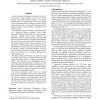Free Online Productivity Tools
i2Speak
i2Symbol
i2OCR
iTex2Img
iWeb2Print
iWeb2Shot
i2Type
iPdf2Split
iPdf2Merge
i2Bopomofo
i2Arabic
i2Style
i2Image
i2PDF
iLatex2Rtf
Sci2ools
ISMB
2000
2000
Analysis of Gene Expression Microarrays for Phenotype Classification
Several microarray technologies that monitor the level of expression of a large number of genes have recently emerged. Given DNA-microarray data for a set of cells characterized by a given phenotype and for a set of control cells, an important problem is to identify "patterns" of gene expression that can be used to predict cell phenotype. The potential number of such patterns is exponential in the number of genes. In this paper, we propose a solution to this problem based on a supervised learning algorithm, which differs substantially from previous schemes. It couples a complex, non-linear similarity metric, which maximizes the probability of discovering discriminative gene expression patterns, and a pattern discovery algorithm called SPLASH. The latter discovers efficiently and deterministically all statistically significant gene expression patterns in the phenotype set. Statistical significance is evaluated based on the probability of a pattern to occur by chance in the co...
Computational Biology | Gene Expression | Gene Expression Patterns | ISMB 2000 | Statistically Significant |
| Added | 01 Nov 2010 |
| Updated | 01 Nov 2010 |
| Type | Conference |
| Year | 2000 |
| Where | ISMB |
| Authors | Andrea Califano, Gustavo Stolovitzky, Yuhai Tu |
Comments (0)

